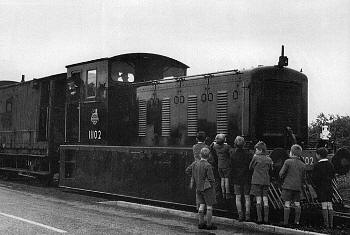The Wisbech and Upwell Tramway: Rolling Stock

GER Class G15 (LNER Y6) 0-4-0 Steam Trams
The possibility of using electricity and 'Kitson type' trams was considered during the planning of the line, but it was eventually decided to build steam trams. The GER's Locomotive Superintendent, T.W. Worsdell, designed these small locomotives to meet this need. They had a distinctive wooden body resembling a goods brake van. To meet the requirements of the Board of Trade Railway Inspectorate, they were fitted with cowcatchers, side skirts, condensing apparatus, spark arrestors, automatic governors, and warning bells. They were also designed with controls at both ends, and sliding windows on the sides, front, and rear.
Ten of these GER Class G15 locomotives were built between 1883 and 1897. When rebuilt in the early 20th Century, they were fitted with the same 140psi boilers used on the newer J70s. The last G15 / Y6 was withdrawn in 1952, and survived at the Stratford paint shop for about a year before being cut up.

GER Class C53 (LNER J70) 0-6-0 Steam Trams
With increasing traffic in the early 20th Century, James Holden designed a more powerful 0-6-0 version of the Class G15 locomotives. Visually these were very similar, but boasted outside cylinders with Walschaerts valve gear, and a 140psi boiler. This compared to the Y6's 120psi boiler and inside cylinders with Stephenson valve gear.
A total of twelve were built between 1903 and 1921, for use on the Wisbech & Upwell and a number of dock railways. With the arrival of the new Drewry diesel shunters, the last scheduled steam service on the tram line was in 1952, but No. 68222 stayed until March 1953 as a backup. The last four J70 was withdrawn from the British Railways system in 1955.

Y10 0-4-0 'Super Sentinel'
The single cab Sentinel Shunters (Y1 & Y3) proved a great success with the LNER, and in 1930 two double cab units were ordered for use on the Wisbech & Upwell. These were gear driven by two 100hp Sentinel steam engines running off the same vertical boiler. They were not a great success on the Wisbech & Upwell due to their high water consumption, and were quickly moved to Yarmouth Quay. The last was withdrawn from service (still at Yarmouth) in 1952.

Drewry Diesel Shunters (BR Class 04)
Two of these were introduced by British Railways on the Wisbech & Upwell in 1952. After successful trials, the last steam service was scheduled for 4th July 1952. The Drewry Shunters would continue to haul all of the line's traffic until closure a decade later.
As with the preceding steam engines, the Wisbech & Upwell's Drewry shunters were fitted with cowcatchers and side skirts.

One of the Wisbech & Upwell Drewry Shunters, D2203, survives in preservation and is currently being restored by the Embsay and Bolton Abbey Steam Railway.
Coaches and Vans

From the very beginning, the Wisbech & Upwell used its own special passenger stock. Initially, only four wheelers were used, but bogie coaches were introduced in 1884. The coaches had balconies at each end and a drawbridge type gangway between coaches. Each balcony had an emergency hand-brake wheel. The coaches looked squat and low-lying due to the need to handle raised track and the absence of platforms at some of the depots.
There were three four-wheeled composites (Nos. 1, 2, 5); three third class four-wheeled composite (Nos. 3, 4, 6); one composite bogie (No. 7); and one third class bogie coach (No. 8). The four wheeled guard's van was No. 16; and a special luggage van was No. 9.
When passenger services ceased, some of the coaches were moved to the Kelvedon & Tollesbury Light Railway. The luggage van was transferred to Elsenham & Thaxted line. The two bogie coaches survived into BR ownership on the Kelvedon & Tollesbury.
Fruit, flowers, and parcels were carried on conventional GER 4 wheeled vans. Conventional main line stock was used for other goods traffic.
Next Page: Toby and Mavis.
| Introduction | History | Route | Rolling Stock | Toby & Mavis | Further Reading |